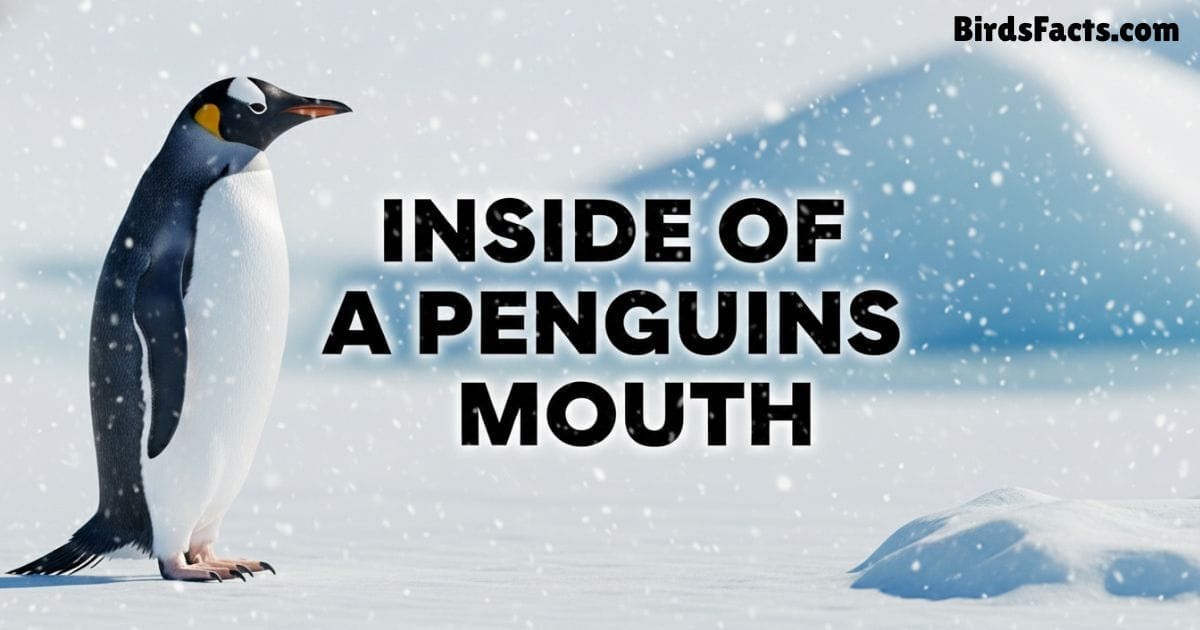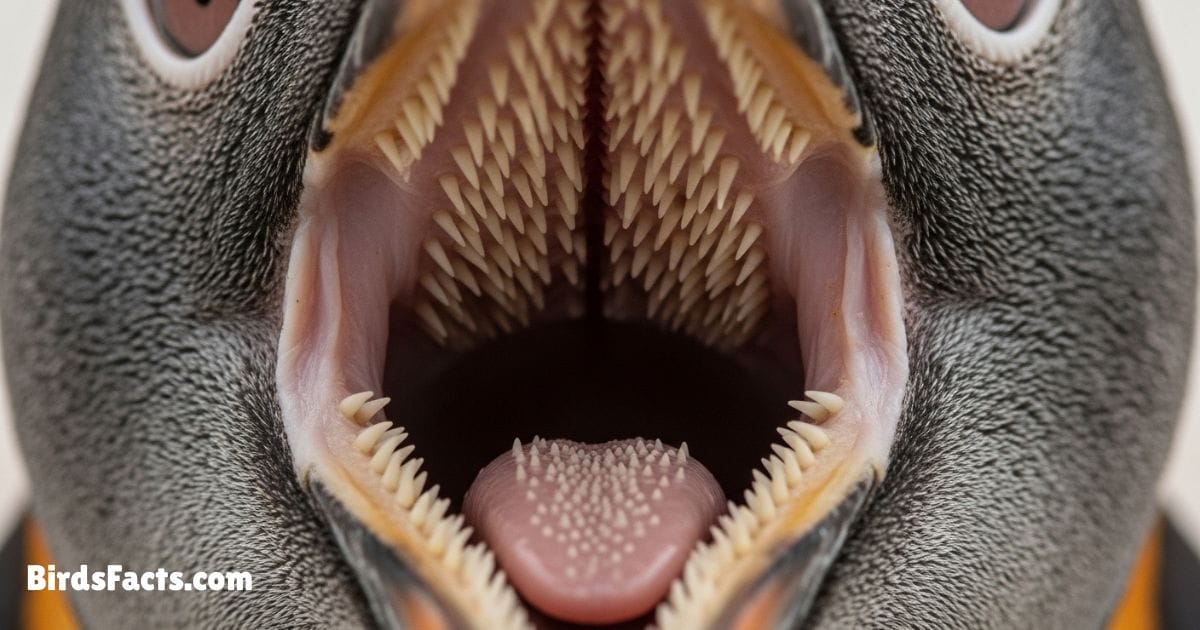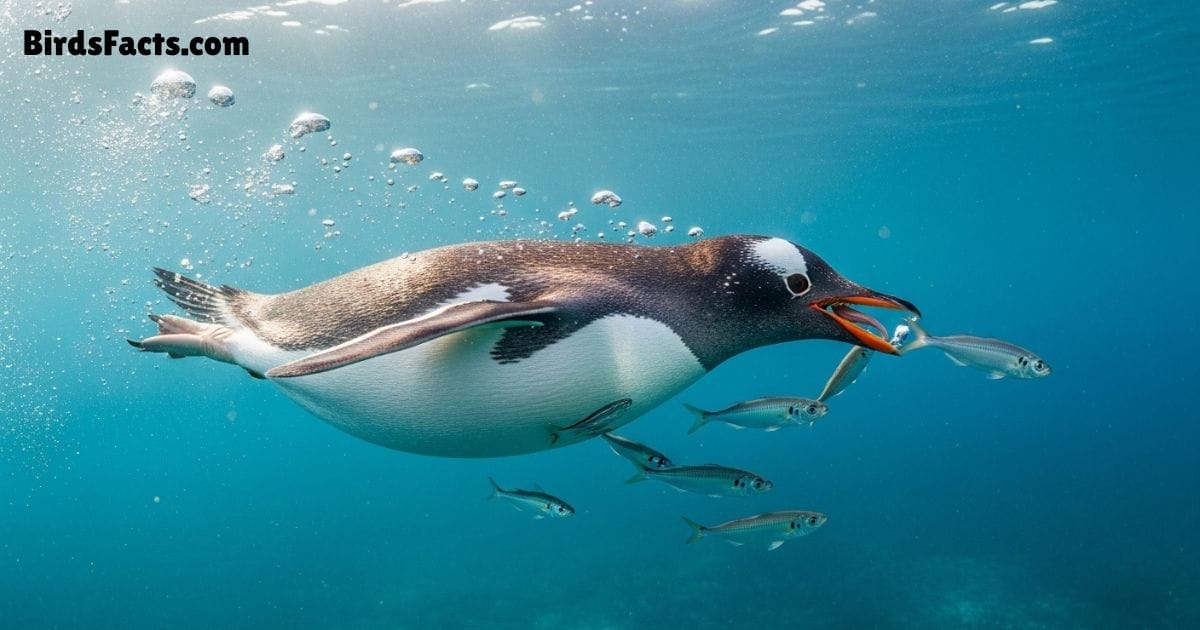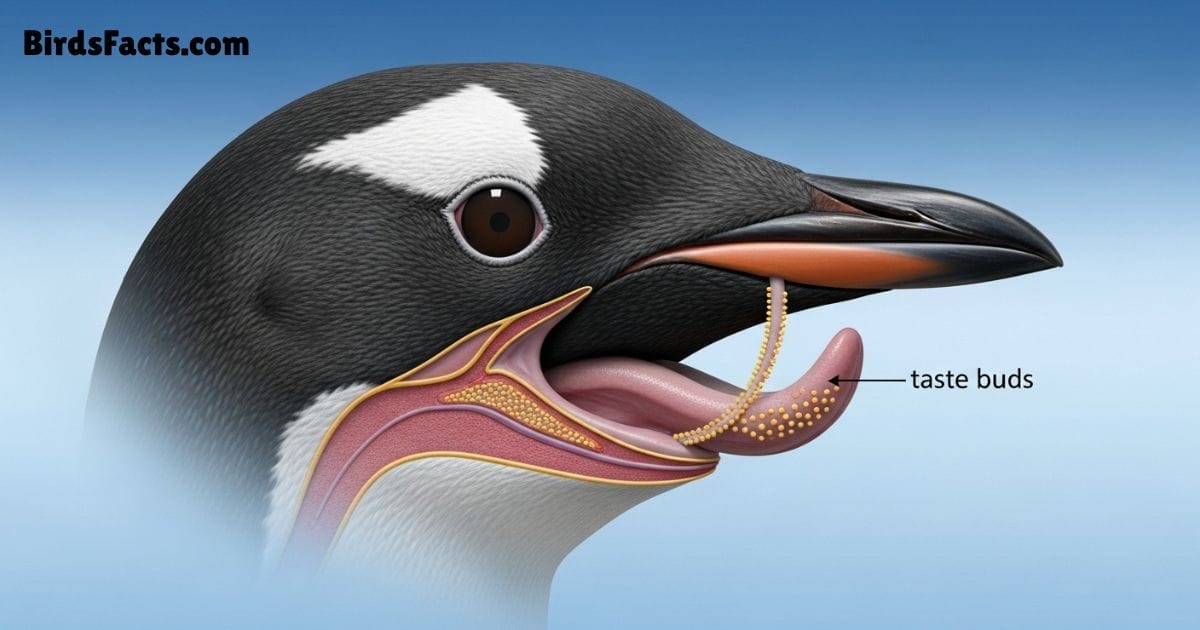
Inside of a Penguins Mouth
Harmless Bird But The Truth About Inside Of A Penguins Mouth Can Surprise You. Instead Of Smooth Skin Their Mouths Are Lined With Sharp Backward Pointing Spines That Look Almost Scary Up Close. It’s One Of Nature’s Strangest Designs Built For Survival Not Looks.
In This Post We’ll Explore What’s Really Going On Inside Of A Penguins Mouth From Those Unusual Spines To How They Help Penguins Eat Slippery Fish. You’ll Learn Why Their Mouths Look So Different What Purpose Each Part Serves And How It Connects To Their Cold-ocean Lifestyle.
Why People Are Curious About a Penguin’s Mouth

Curious view Inside of a Penguins Mouth showing pink throat and spiny ridges.
Many People Are Fascinated By The Strange And Almost Alien Appearance Inside Of A Penguins Mouth. Viral Photos Often Show Sharp Ridges And Spines That Seem Dangerous Leading People To Wonder If Penguins Have Teeth. The Truth Is Much More Interesting Those Spikes Are Not Teeth But Soft Keratin Structures Called Papillae.
These Papillae Make The Inside Of A Penguins Mouth One Of The Most Remarkable Examples Of Natural Design They Help Penguins Survive Where Other Birds Could Not Gripping Wet Slippery Prey Underwater And Swallowing It Whole.
Anatomy Overview What’s Inside of a Penguin’s Mouth?
If You Could Look Closely Inside Of A Penguins Mouth You Would See A Detailed System Of Ridges And Spines Instead Of A Flat Surface The Tongue Roof And Throat Are All Covered With Papillae Tiny Backward-facing Spikes That Prevent Prey From Slipping Out.
The Inside Of A Penguins Mouth Is Built For Efficiency The Inner Lining Is Tough Yet Flexible Made From Keratin That Resists Wear From Scales And Cold Water Everything Inside Works Together To Trap And Move Fish Smoothly Toward The Stomach.
Tongue Covered in Backward Spines
The Most Striking Part Inside Of A Penguins Mouth Is Its Tongue. Instead Of Being Soft Or Flat Like A Human’s It’s Covered With Hundreds Of Sharp Papillae Pointing Toward The Throat. These Act Like Hooks That Grab Fish And Guide Them Backward While The Penguin Swallows.
Each Papilla Is Made Of Keratin The Same Material That Forms Our Hair And Nails Making It Extremely Strong. The Inside Of A Penguins Mouth May Look Scary But It’s An Incredible Design Built For Survival Helping Penguins Feed Quickly In Icy Seas Without Losing Their Prey.
The Roof and Throat Filled with Tiny Spikes

The roof and throat Inside of a Penguins Mouth lined with tiny backward spikes.
When You Look Closely Inside Of A Penguins Mouth The Roof And Throat Are Lined With Hundreds Of Tiny Backward Facing Spines. These Spikes All Point Toward The Stomach Creating A One Way Path For Food. Once A Fish Or Krill Goes In It Can’t Escape. This Spiny Design Allows Penguins To Eat Efficiently Underwater Without Worrying About Losing Their Prey.
Although The Spikes Look Intimidating They Aren’t Sharp Enough To Harm The Penguin Itself. Instead They Act Like Small Hooks Ensuring That Everything Caught Stays Secure As It Moves Deeper Down The Throat. The Inside Of A Penguins Mouth May Look Fierce But It’s Perfectly Designed For Safety And Survival.
The Keratin Material Same Protein as Hair and Nails
The Spines Inside Of A Penguins Mouth Are Made Of Keratin The Same Protein Found In Human Hair Nails And Animal Claws This Makes Them Both Tough And Flexible Ideal For Handling Slippery Fish. Unlike Bone Keratin Doesn’t Chip Or Break Easily So It Can Endure Years Of Feeding In Freezing Waters.
Keratin Gives The Inside Of A Penguins Mouth Its Hard Textured Surface Protecting It From Damage Caused By Fish Scales And Shells. This Strong Material Helps Penguins Feed Repeatedly In Icy Seas Without Any Internal Injury Proving How Evolution Adapts To Even The Harshest Diets.
Do Penguins Have Teeth?

Comparison showing Inside of a Penguins Mouth versus mammal teeth structure.
At First Glance The Sharp Ridges Inside Of A Penguins Mouth Might Look Like Rows Of Teeth. However Penguins Don’t Have True Teeth At All. Instead They Use Their Keratin Spikes To Grip And Swallow Prey Whole. These Spines Act As Natural Substitutes For Teeth Performing The Same Function Without Any Actual Enamel Or Roots.
The Inside Of A Penguins Mouth Is Proof That Penguins Don’t Need Teeth To Eat Effectively. Their Beak And Papillae System Work Together To Trap Fish Securely Even During Fast Underwater Dives. It’s A Design Focused Entirely On Performance Not Appearance.
Why Are There Spines Inside a Penguin’s Mouth?
The Main Reason There Are Spines Inside Of A Penguins Mouth Is To Keep Slippery Prey From Escaping Penguins Mainly Eat Fish Squid And Krill All Creatures That Are Difficult To Grip In Water. The Backward-facing Papillae Act Like Tiny Barbs Catching And Directing Food Toward The Throat While Preventing It From Sliding Out.
These Spines Are A Brilliant Evolutionary Tool. The Inside Of A Penguins Mouth Uses Them As A Built-in Feeding Mechanism Allowing Penguins To Hunt In Cold Turbulent Waters Where Precision And Speed Are Essential For Survival.
How Penguins Use Their Mouths to Eat and Hunt
Every Feature Inside Of A Penguins Mouth Works Together To Make Feeding Effortless. The Beak Helps Catch Prey The Tongue Grips It With Papillae And The Throat’s Spikes Guide It Down In One Smooth Motion Penguins Often Swallow Their Food Whole Saving Energy And Avoiding The Need To Surface Too Often.
This System Shows Just How Efficient Penguins Are As Hunters. The Structure Inside Of A Penguins Mouth Isn’t Just For Looks It’s A Fully Functional Design Made For One Purpose: To Help These Birds Feed Quickly And Effectively In The Freezing Ocean.
What Scientists Found About Penguin Mouths
Scientists Who Have Studied The Structure Inside Of A Penguins Mouth Discovered That It’s Far More Advanced Than It Appears Research Shows That The Papillae Are Made From Tough Keratin And Arranged In Precise Rows That Maximize Grip On Fish Microscopic Studies Also Reveal That The Tongue Muscles Are Incredibly Strong Helping Penguins Push Food Backward In One Smooth Motion.
According To Zoological Research The Inside Of A Penguins Mouth Functions Like A Biological Conveyor Belt. Once Prey Enters The Flexible Papillae Bend Just Enough To Move Food Toward The Throat But Resist When It Tries To Escape. This Clever Mechanism Shows Just How Well Penguins Have Evolved To Dominate Their Underwater Environment.
Inside of a Penguins Mouth Compared to Other Birds

Comparison Inside of a Penguins Mouth and other bird species showing texture difference.
When You Compare What’s Inside Of A Penguins Mouth To Other Birds The Difference Is Dramatic. Seagulls Ducks And Pelicans Have Smoother Mouths Designed Mainly For Scooping Or Swallowing Not Gripping. Penguins However Need To Secure Fast Slippery Prey Underwater So Their Mouths Have Evolved To Do Exactly That.
The Papillae Inside Of A Penguins Mouth Make It One Of The Most Specialized Feeding Systems Among All Birds While Most Species Rely On Speed Or Large Beaks Penguins Depend On Internal Grip Strength A Unique Feature That Reflects Their Aquatic Lifestyle And Cold-ocean Diet.
Amazing Adaptations That Help Penguins Survive

Penguin underwater feeding using adaptations Inside of a Penguins Mouth to catch fish.
The Structures Inside Of A Penguins Mouth Are Just One Of Many Adaptations That Make Penguins Remarkable Survivors Their Dense Feathers Trap Heat Their Bodies Are Streamlined For Swimming And Their Mouths Are Built To Feed Efficiently In Icy Waters Together These Features Create A Perfect Balance Of Warmth Strength And Skill.
Every Ridge And Spike Inside Of A Penguins Mouth Serves A Clear Purpose To Help Penguins Catch Enough Food To Survive In An Environment Where Every Meal Counts This Combination Of Physical And Behavioral Evolution Shows How Finely Tuned These Birds Are To The Frozen Oceans They Inhabit.
What Does a Penguin’s Mouth Look Like Inside?
Visually The Area Inside Of A Penguins Mouth Looks Like Something From A Science-fiction Movie. The Tongue And Upper Palate Are Covered In Sharp Backward-curved Spines That Create A Tunnel-like Effect Leading To The Throat. These Papillae Glisten In Shades Of Pink Yellow And Gray Depending On The Species.
Despite Its Fearsome Appearance The Inside Of A Penguins Mouth Is A Marvel Of Natural Engineering. Every Texture And Curve Has Evolved To Make Eating Underwater Fast Efficient And Effortless. What Might Look Strange Or Scary Is In Truth One Of Nature’s Smartest Survival Tools.
What Are the Spines Inside a Penguin’s Mouth?
The Spines Inside Of A Penguins Mouth Are Known As Papillae And They’re Made Of Keratin The Same Tough Material Found In Human Nails And Hair. These Papillae Aren’t Teeth But They Perform A Similar Role By Gripping Fish And Preventing Them From Sliding Out Each Spine Curves Backward Toward The Throat Guiding The Prey In One Direction Only Straight Down.
Because Penguins Catch Food Underwater The Spines Inside Of A Penguins Mouth Are Essential Without Them Their Slippery Prey Could Easily Escape These Small Flexible Hooks Are A Perfect Example Of How Even The Tiniest Details In Nature Have Evolved To Serve A Powerful Purpose.
Why Do Penguins Have Weird Mouths?
People Often Call The Inside Of A Penguins Mouth “weird” Because Of The Unusual Spikes And Ridges. What Looks Strange To Us Is Actually An Incredible Adaptation For Survival. Penguins Don’t Need Teeth For Chewing; Instead They Need Grip And Control To Handle Fast Moving Fish. Those Spines Give Them Exactly That.
In Reality There’s Nothing Weird About The Inside Of A Penguins Mouth It’s Just Highly Specialized. Evolution Designed It Not For Looks But For Effectiveness. Every Ridge Hook And Texture Works Together To Make Penguins Excellent Hunters In The Most Unforgiving Seas On Earth.
Are All Penguin’s Mouths the Same?
Not All Penguins Have Identical Mouth Structures But The General Design Inside Of A Penguins Mouth Is Consistent Across Species Emperor And King Penguins For Example Have Slightly Larger Papillae Suited For Catching Bigger Fish Smaller Species Like Adélie Or Gentoo Penguins Have Finer More Closely Packed Spines To Grip Tiny Krill.
Even Though The Details Vary The Function Stays The Same The Papillae Inside Of A Penguins Mouth Help Every Species Feed Successfully In Its Own Habitat Showing How Nature Tailors Designs To Specific Environmental Needs.
Can Penguins Bite?
Yes Penguins Can Bite And It Can Hurt The Beak Is Sharp And Strong Enough To Pinch Or Cut Especially If The Bird Feels Threatened However The Spines Inside Of A Penguins Mouth Are Not Used For Biting. They’re Too Soft And Flexible For Attack Their Only Purpose Is To Help Catch Food.
While A Penguin’s Bite Might Surprise You It’s Not Because Of The Inside Of A Penguins Mouth But Rather The Beak Itself. Penguins Are Naturally Defensive Especially During Nesting Or When Guarding Their Chicks But They Aren’t Aggressive Animals By Nature.
Do Penguins Have a Sense of Taste?

Diagram Showing Inside Of A Penguins Mouth Highlighting Limited Taste Buds And Keratin Papillae Designed For Texture Rather Than Flavor.
Scientists Believe That Penguins Have A Very Limited Sense Of Taste. Studies Show That Their Taste Buds Are Either Underdeveloped Or Nearly Absent Meaning They Can’t Detect Sweet Or Savory Flavors Like Humans Do. Instead The Inside Of A Penguins Mouth Is Built For Texture Not Taste. The Focus Is On Catching Gripping And Swallowing Prey Not Enjoying Flavor.
Because Penguins Eat Their Food Whole And Live In Freezing Conditions Taste Isn’t Important For Their Survival. The Structure Inside Of A Penguins Mouth Proves That Efficiency Matters More Than Sensory Pleasure In The Animal Kingdom What Penguins Lack In Taste They Make Up For In Precision And Adaptability.
What Is in a Penguin’s Mouth?
When You Look Closely Inside Of A Penguins Mouth You’ll See Several Distinct Parts Working Together. There’s The Strong Muscular Tongue Covered In Papillae; The Roof Lined With Backward-facing Spikes; And The Tough Throat That Guides Food Down. All Of These Features Are Built From Keratin And Are Perfectly Adapted For One Job Eating Underwater.
Unlike Most Birds The Inside Of A Penguins Mouth Doesn’t Contain Salivary Glands For Chewing Or Digestion. Instead Penguins Rely On Their Stomach Acids To Break Down Whole Prey. It’s A Simple But Incredibly Effective System Designed To Match Their Fast-paced Aquatic Lifestyle.
Frequently Asked Questions (FAQs)
What Is Inside A Penguin’s Mouth?
Inside Of A Penguins Mouth You’ll Find Sharp Backward-pointing Spines Called Papillae That Help Them Grip Slippery Fish And Swallow Easily.
Do Penguins Have Teeth?
No Inside Of A Penguins Mouth There Are No Real Teeth Only Keratin Spines That Look Like Teeth But Serve To Hold Prey In Place.
How High Is A Penguin’s Iq?
While Inside Of A Penguins Mouth Shows A Fascinating Design For Hunting Penguins’ Intelligence Lies In Their Memory And Teamwork Not Measurable Iq.
Why Can’t We Eat Penguins?
We Can’t Eat Penguins Because They Are Protected Species And Inside Of A Penguins Mouth Their Strong Fishy Smell Hints That Their Meat Wouldn’t Taste Pleasant.
What Do Penguins Use Their Tongues For?
Inside Of A Penguins Mouth The Tongue Is Covered In Spiny Papillae That Grip Fish Tightly And Push Them Down The Throat Without Slipping.
Conclusion
The Inside Of A Penguins Mouth Might Look Strange Or Even Frightening At First But It’s Actually A Masterpiece Of Evolution Every Papilla Ridge And Spike Plays A Role In Helping Penguins Thrive In Cold Oceans Where Food Is Hard To Catch. Their Mouths Aren’t Built For Beauty Or Comfort They’re Built For Survival.
From Gripping Fish In Icy Waters To Swallowing Food Whole The Inside Of A Penguins Mouth Represents Nature’s Brilliance In Action. It Reminds Us That Even The Most Unusual Looking Creatures Are Perfectly Designed For The Challenges They Face. What Seems Weird To Humans Is In Truth One Of The Most Efficient Feeding Systems In The Animal World.
Also Read








